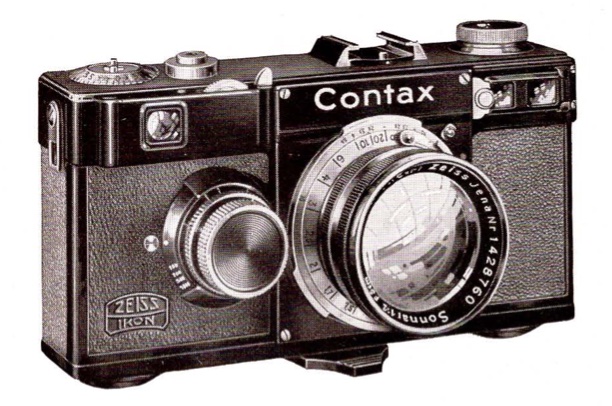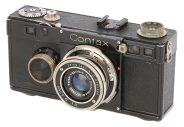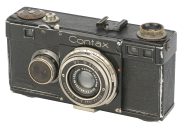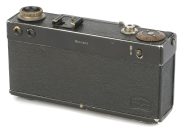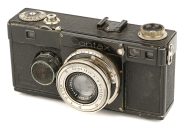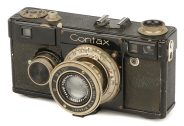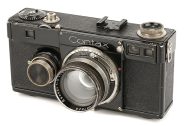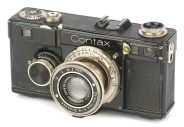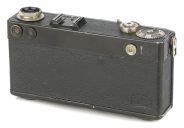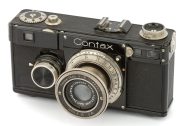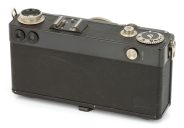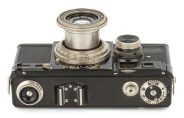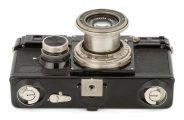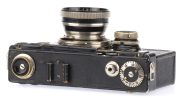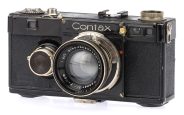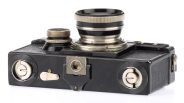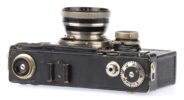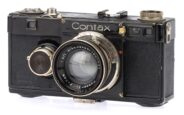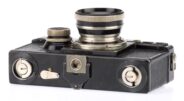Contax I
35mm MF film rangefinder camera • Discontinued
- Announced:
- · 1932
- Production status:
- ● Discontinued
- Country of design:
- · German Reich
- Order No.:
- · 540/24 L - body with TESSAR f/3.5, 5 cm.
- · 540/24 P - body with TESSAR f/2.8, 5 cm.
- · 540/24 N - body with SONNAR f/2, 5 cm.
- · 540/24 J - body with SONNAR f/1.5, 5 cm.
- System:
- · Contax (1932)
Specification
| Format: | |
| 35mm full frame | |
Film type: | 135 cartridge-loaded film |
| Contax [34.85mm] | |
| Shutter: | |
Type: | Focal-plane |
Model: | Mechanical |
Speeds: | 1/2 - 1/1250 + B, T |
| Exposure: | |
Exposure metering: | None |
Exposure modes: | Manual |
| Rangefinder and Viewfinder: | |
Rangefinder: | Built-in |
Viewfinder: | Built-in |
Bright-line frames: | - |
Parallax compensation: | - |
| Physical characteristics: | |
Weight: | <No data> |
Dimensions: | <No data> |
Manufacturer description
In the CONTAX, Zeiss Ikon has produced a camera so universal in scope that it really represents several cameras in one. This extreme versatility is the result of many constructional features, of the use of interchangeable Zeiss lenses, and of numerous accessories. The CONTAX takes critically sharp negatives under the most difficult lighting and speed conditions. Indoors or out, in daylight or in ordinary artificial light, "CONTAX gets the picture."
With its load of thirty-six exposures on one roll, you can snap one shot after another in quick succession. Ready at an instant's notice, you catch your subjects unposed - true-to-life candid shots full of character and human interest... children at play, friends in interesting attitudes, banquet scenes, stage pictures, etc. And at sporting events your CONTAX will snap the fastest action, getting all the detail and tone value that make a picture pulse with life. If you are a nature fan you will find your CONTAX invaluable in taking telephoto shots of birds and wild animals, or close-up studies of insects, flowers, etc. Or if your interest lies along scientific lines, your same CONTAX can readily be adapted to the making of copies from books, charts, prints, etc., or photomicro pictures of every description.
In short, the CONTAX offers unlimited scope in picture making. It opens the way to new and exciting adventures in photography.
To secure such extremely sharp negatives as the CONTAX makes - negatives capable of considerable enlargement - 35 mm. motion picture film is used. The Zeiss lenses are especially designed to insure sharpest definition over the whole negative. Minutely accurate focusing - so necessary in the miniature camera - is assured by a mechanism of extra-ordinary precision, yet easily operated. The film lies absolutely flat in the film gate to insure the same accuracy as with the plate and plate-holder, and the shutter is so designed that all single points of the negative receive even exposure.
CONTAX is a product of Zeiss Ikon, Dresden, Europe's largest and leading camera concern. In design, construction, and operation, the CONTAX is the foremost 35 mm. miniature camera.
***
CONTAX is now available in two models, CONTAX I and the new CONTAX II. Basically, both models offer the same fundamental photographic possibilities and accommodate the same range of lenses and accessories. Tbey differ, however, in the following respects.
The CONTAX I is finished in nickel and black enamel, whereas the CONTAX II is finished in chromium, partly dull and partly bright.
In the new CONTAX II (Chromium) the range-finder and view-finder are combined in one opening, giving speedier manipulation and a larger image. The winding knob is situated on top of the camera with the shutter release conveniently located in the center of the knob. The top speed has been increased from 1/1000th to 1/1250th of a second. The whole scale of shutter speeds is always visible. Adjustments can be made both before and after winding the shutter, same as with CONTAX I. A self-timing device permits delayed action release for taking your own picture; the release takes place automatically after a delay of approximately twelve seconds. The same mechanism also permits an automatic exposure of one second.
The CONTAX I (Black) which has so many friends, will be continued. The new CONTAX II (Chromium) is priced somewhat higher.
***
CONSTRUCTION OF CONTAX
Shape of body
To avoid blurring due to movement of the camera during exposure, the camera must be firmly held by the photographer. Weight and dimension of the camera influence this. Research and actual experiment have proved that best results are obtained with a camera almost rectangular, with corners slightly rounded off. This is the shape of the CONTAX. The rectangular shape helps the operator to keep the camera level and to avoid a tilted position. The CONTAX has an all-metal body of light metal casting. Cast camera bodies are known for their rigidity.
Accessibility
All cameras, especially those using roll or motion picture film, must be kept thoroughly clean. Dust or small particles of film or perforation chips accumulate and may cause trouble. The surface around the picture aperture and the sliding track of the film require special attention. The interior of the CONTAX is easily and completely accessible. Simply remove the back, and the camera is open for easy and thorough cleaning. This removable back has many other advantages. First, it renders the insertion of daylight loading spools as easy as in any roll film camera, and further, it permits the use of a ground glass screen, plate back, and other accessories. This detachable back is made of a specially rigid metal. When fitted in place, the camera is absolutely light-tight, and the spring pressure plate ensures that the film will be kept flat in the pictnre aperture at all times.
Focusing
For negatives which are to be enlarged, as practically all miniature negatives are, there must be no guesswork. They must be absolutely clear and sharp. The only sure way of avoiding errors of focus is to couple the focusing mechanism of the lens wi th an accurate range-finder, as embodied in the CONTAX.
Operating the knnrled wheel actuates the range-finder and at the same time automatically focuses the lens.
The CONTAX Range-finder
The accuracy of an optical range-finder depends to a great extent upon the length of its so-called optical base. The ideal range-finder must cover the requirements of short- and long- distance photography.
The CONTAX is equipped with a range-finder of approximately the full length of the camera - about four inches. This gives it a high degree of accuracy for all lenses and for all distances.
The range-finder of the CONTAX is built-in so that it forms an integral part of the camera body and is completely protected against damage. It is of the wedge-type construction which is not only inherently more accurate but also more durable and shock-proof.
The range-finder gives an extremely bright and clear image. The mechanism of an optical range-finder brings together two images of the same object. When they are exactly superimposed the correct focus has been obtained. It is not always easy to superimpose images of the same color. Tinted glass, which is frequently used for one image, reduces up to forty percent of the light, and thereby greatly decreases the efficiency of a range-finder. The CONTAX avoids this disadvantage by the ingenious arrangement of a semi-transparent gilded mirror and a prism producing two images, one red and one green (complementary colors). These, when brought together in focus, produce one clear and brilliant object in approximately natural colors. The automatic coupling of the range-finder to the focusing mount of the lens insures an extremely high degree of accuracy in focusing.
The Automatic Focusing Device of the CONTAX
In designing the focusing mechanism of the CONTAX, two very important points had to be taken into consideration. First, the highest possible accuracy of mechanical parts; second, to make them immune to external influences which might destroy the exact relation between lens and measuring device. The mechanism was, therefore, designed to insure utmost accuracy. It was made solid, substantial, and rigid, so that it would withstand wear and tear, and it was housed within the camera so that all mechanical parts would be fully protected.
The user superimposes the images by observing the action of the range-finder, as he rotates the knurled wheel, which at the same time automatically focuses the lens. Once the two images are perfectly superimposed, their vertical lines forming one line, the lens is in exact and critical focus.
CONTAX lenses can be interchanged without altering the relative position of the focusing mechanism. It is always possible to use the range-finder even when the lens has been removed.
The CONTAX All-melal Focal-plane Shutter
A truly universal camera such as the CONTAX must be equipped with a focal-plane shutter, for only a focal-plane shutter permits of the shortest possible exposure and the best possible use of the light entering the lens. The CONTAX shutter travels over the shortest distance of the film, vertically, thereby assuring even illumination of the negative.
The focal-plane shutter of the CONTAX is automatically coupled with the film mechanism so that the winding of the shutter automatically transports the film. This prevents accidental double exposures. However, when desired, any number of consecutive exposures may be made on the same negative.
The CONTAX shutter is the result of many years of scientific and technical research, both with regard to design and material. The material is a light metal with unlimited durability and a tremendously greater resistance to changes in temperature and climate, as well as to mechanical wear and tear, than a focal-plane shutter made of any other material.
The shutter consists of two metal blinds set with extreme accuracy. The speeds of the shutter are:
for the CONTAX I (Black): 1/2, 1/5, 1/10, 1/25, 1/50, 1/100, 1/200, 1/500, and 1/1000th of a second, B and T.
for the CONTAX II (Chromium): 1/2, 1/5, 1/10, 1/25, 1/50, 1/125, 1/250, 1/500, and 1/1250th of a second, B and T.
At all speeds, the CONTAX metal shutter runs smoothly and quietly. Exposures at 1/25th or 1/50th of a second, camera held in hand, show a sharpness not heretofore attained by amateur photographers, and the experienced photographer may quite easily use exposures of 1/10th or even 1/5th of a second with the camera held in hand.
The first focal-plane shutter ever produced was made by C. P. Goerz, now merged in Zeiss Ikon. The long and highly specialized experience of Zeiss Ikon with the difficult problem of design and construction of focal-plane shutters, has resulted in the all-metal focal-plane shutter which is used in the CONTAX, and which embodies their knowledge, tradition, and standards.
Picture Aperture and Film Guide
To obtain a perfect negative, it is, of course, necessary that the film lie absolutely flat - as flat as a plate. In the CONTAX the film passes through an extremely shallow channel with a spring pressure plate on the reverse side of the film. It is held absolutely flat and in the focal-plane, which insures the sharpest negative possible.
Film Loading
In the CONTAX - you use standard perforated 35 mm. motion picture film in lengths of approximately sixty-three inches. Each film spool gives thirty-six pictures of 24 x 36 mm., approximately 15/16 x 1 3/8 inches. The automatic exposure counter shows the number of exposures made.
Double exposures (except where delliberately intended) are completely eliminated by the automatic film transport which, when winding the shutter, automatically transports the film necessary for the next exposure.
We recommend the use of CONTAX daylight loading spools with paper leader and paper trailer, which are inserted and removed from the camera in plain daylight in the same manner as you would load and unload any roll film camera. CONTAX daylight loading spools are supplied by the leading film manufacturers throughout the world.
When the photographer desires to use bulk film which is more economical and may be obtained in lengths of twenty-five to one hundred feet or to use shorter lengths of film, magazines are provided which may be loaded in the dark room with the requisite lengths of film. It is possible to use two magazines, winding the film from one magazine into the other, so that the film may be removed from the camera after any given number of exposures.
Similar cameras (8)
| Model | Shutter | Metering | Modes | Year |
|---|---|---|---|---|
| Kiev-4 akaКиев-4 |
M, 1/1250 | Window | M | 1957 ● |
| Kiev-4A akaКиев-4А |
M, 1/1250 | -- | M | 1958 ● |
| Kiev-4AM akaКиев-4АМ |
M, 1/1000 | -- | M | 1980 ● |
| Kiev-4M akaКиев-4М |
M, 1/1000 | Window | M | 1976 ● |
| Kiev-5 akaКиев-5 |
M, 1/1000 | Window | M | 1968 ● |
| Kiev-III[A] akaКиев-III[А] |
M, 1/1250 | Window | M | 1952 ● |
| Kiev-II[A] akaКиев-II[А] |
M, 1/1250 | -- | M | 1947 ● |
| VTSVS akaВТСВС |
M, 1/500 | -- | M | 1949 ● |
